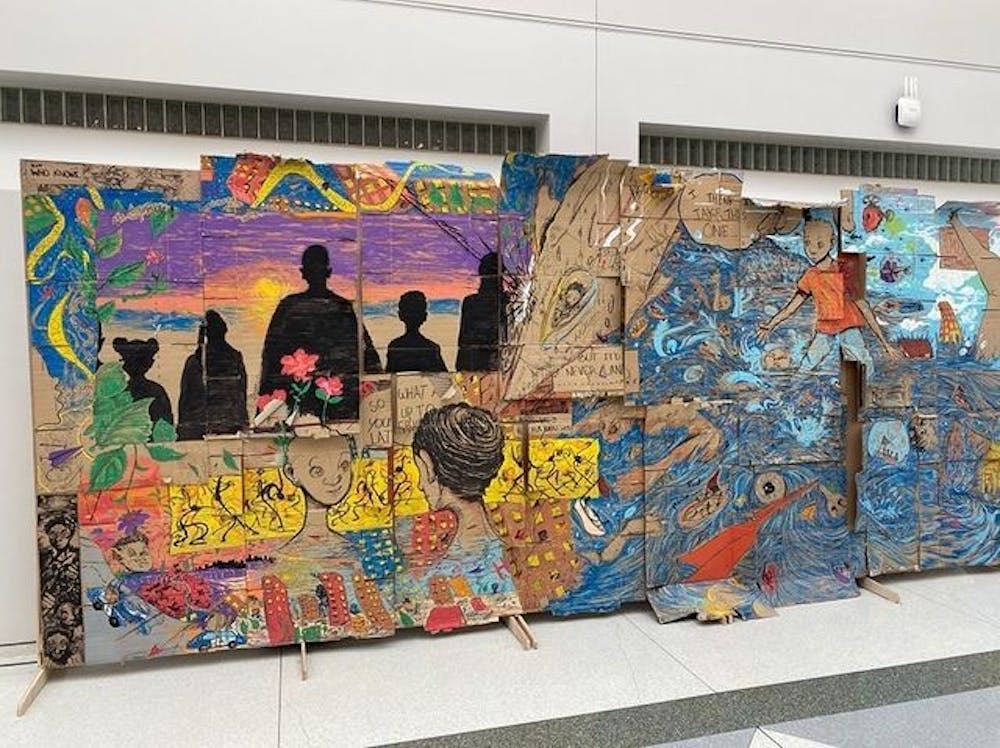The Center for the Arts’ atrium walls are impossible to miss.
On either side, attendees are greeted by welcoming pictures that are meant to evoke the excitement of street art as part of “The City Talks to Itself Pt. 2” — an exhibit which launched in September, and will run until May 27.
But the details that pack these excellent pieces serve as more than just a gentle nudge into the world of imagination. They tell the personal stories of each artist: Buffalo-based creator Johny Chow’s “Chow Monstro” illustrates his love of weapons, while Tayron Lopez, a Master of Fine Arts candidate hailing from New York City, impresses with his mural titled, “An Attempt at Illustrating the Ineffable while Walking to East 163rd St in the Bronx.”
“Chow Monstro” is an eye-catching piece at first sight. A Mickey Mouse body sports a menacing cleaver in one hand, three balloons in the other and an eerie skull where the mouse’s signature smile once was, as Chow depicts a level of duality within the children’s cartoon character.
But to understand the piece, let alone the title, one must first internalize Chow’s background as a touring musician and artist.
“Chow Monstro” is not the title of one piece. It’s both a series of similarly-crafted paintings, as well as his artistic moniker.
While working with heavy metal group Cavalera Conspiracy, Chow found his peers referring to him as “monstro chow,” and the name stuck, eventually evolving into Chow Monstro.
The Mickey Mouse skulls — a concept Chow was able to copyright with just enough tweaking to outskirt the Disney legal team — dates back to his time living in Los Angeles, where he first began utilizing morbid concepts to make his pieces, ranging from bones to razors. After returning to Buffalo, Chow was inspired to create the first installation of his Mickey-centric mural series, which depicted Mickey holding a hand grenade in one hand and the grenade’s pin in the other. Soon, Mickeys began cropping up around Buffalo and beyond.
For “Chow Monstro,” Chow elected to offset his usual dark imagery by placing three balloons in Mickey’s cleaverless hand, made up of the primary colors. The contrast between morbidness and positivity is designed to confuse the viewer.
“Everybody likes primary colors. It gives me a good feeling with the whole Disney vibe,” Chow said. “And then all of a sudden you see a meat cleaver and you see the skull and it’s almost like he’s inviting you in there, ‘Come on, come with me. Let me chop your head off.’”
Additionally, Mickey is accompanied by a pillar dotted with Mickey heads, Pac-Man ghosts and Gucci stripes. This pillar, like Mickey, evokes feelings of comfort and morbidness.
Regardless of the brand he chooses to reference, Chow’s pieces have always had the same overarching intent: familiarity. He compares his work to a picture, “Kiss Kids on Coke,” which depicts the metal band Kiss as children, while they hold Coca Cola cans.
“What pulled me into ‘Kiss Kids on Coke’ is the usage of the lettering of Kiss for the Kiss kids, and then the coat is written in the coat,” Chow said. “I wanna have pieces that will pull people in, and familiarity always draws people in.”

But just a few feet away is a piece that tells a very different story:
“An Attempt at Illustrating the Ineffable while Walking to East 163rd St in the Bronx,” drawn on mounds of cardboard, is filled with a variety of pictures and symbols that work together to demonstrate what Lopez would see and hear while walking up and down the titular street.
The title itself evokes strong emotions, as Lopez found the word “ineffable” while creating it.
“I was ultimately trying to depict something that I couldn’t explain to words,” Lopez said. “And so that’s why I chose the word ‘ineffable’ and that long sentence, but I also like the titles to be pretty long because I like them to direct people to what the work is about and also to kind of function as a work of art in itself.”
While the symbols and settings depicted are divided within creatively constructed borders, Lopez credits much of his inspiration to manga and poetry.
Each section of the work ultimately captures a specific moment or feeling and represents part of Lopez’s life growing up on East 163rd Street. He says he thinks being away from his hometown while attending UB actually helped strengthen the vivid ideas the piece paints.
Furthermore, Lopez says he feels geographical differences in sound played a huge role in making his piece.
“The absence of sounds like helicopters or the presence of police cars, ambulances or people in general making noise in the street, there wasn’t a lot of that here [Buffalo],” Lopez said. “And so it allowed for deeper contemplation and allowed for a deeper level of thought.”
Never one to let viewers off easily, the cardboard contains interactable properties which reveal darker pieces of work, which even near the grotesque with images of body parts like a chest cavity or a heart. The juxtaposition serves to do more than just shock onlookers. It essentially represents that there is always “more to the story,” even if the viewer cannot see it.
“[The hidden section evokes] the idea that this piece continues even if [the front section] was removed,” Lopez said. “Now ultimately, there are some parts where it shows that’s not the case. But the idea still stands, [that] there’s more to the story; the story continues.”
Alex Falter is the senior arts editor and can be reached at alex.falter@ubspectrum.com

Alex Falter is a senior arts editor at The Spectrum.





